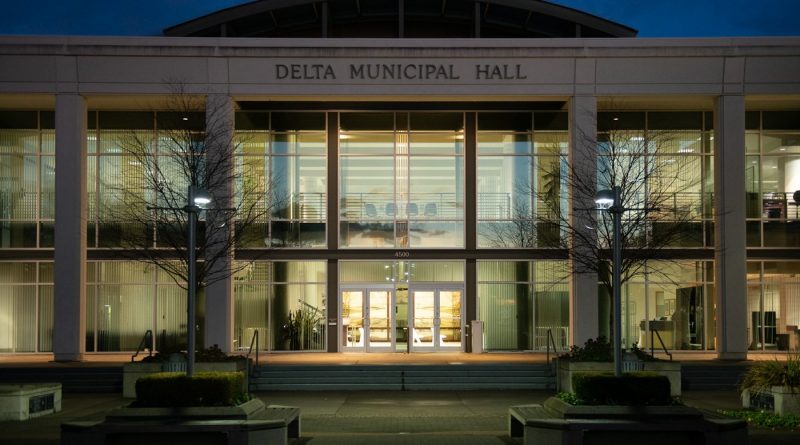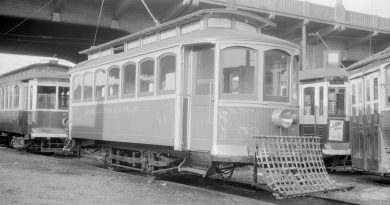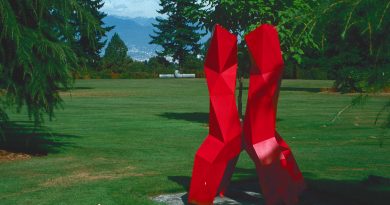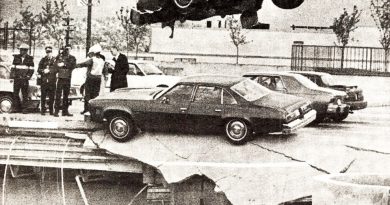1994
Above: Delta’s new municipal hall was completed in 1994.
[Image: Office of Mayor George V. Harvie (Twitter)]
*****************************************
You’ll note that these years include events listed under “Also in . . .” These are events for which we don’t have a specific date. If YOU know the specific date of an event shown there, please notify us . . . and cite the source! Many thanks!
*****************************************
February 9 On Chinese New Year’s Eve, at 9 p.m. “Memory Music” CHQM AM 1320 ended more than 34 years of nostalgic and easy listening music with Bob Hope’s Thanks for the Memories. Moments later it became CHMB with an all-night Chinese program and new multilingual format before moving to all-Chinese seven months later.
March 29 An announcement was made that Vancouver’s newest arena, still under construction, would be named General Motors Place. GM paid $18.5 million for 20-year naming rights. GM Place would be the home of the Vancouver Canucks, who would play their first game here September 23, 1995.
April 1 Langara College was established as an independent public college under the Provincial College and Institutes Act. Langara College programs were first offered in 1965 at King Edward Centre as part of Vancouver City College. The current site on West 49th Avenue has housed the programs since 1970. Visit the College’s web site here.
Langara sponsors 1994 in The History of Metropolitan Vancouver.
April 30 Rick Watson died. His was the sweetest, funniest funeral I’ve ever attended. Rick, whose body was racked by cerebral palsy, died at 41 and left a lot of grieving friends. They told stories at the funeral of his exploits—like the time a friend let him drive his truck in a very remote area, with hair-raising results, or his attempts to plug in a Christmas tree—and the stories got funnier and funnier. The Province took him on as a columnist, and he pecked out his allotted stories one letter at a time with a wand attached to a headband. Rick was born April 14, 1953 in Bowmanville, Ontario.
Spring The 1994 inductees into the Vancouver Board of Trade Hall of Fame (awarded to companies or organizations active for 100 years) were:
- C.H. Cates & Sons Limited
- Hotel Vancouver
- Inchcape Shipping Services
- Murchie’s Tea & Coffee Ltd.
- St. Paul’s Hospital
- The Vancouver Museum
The Vancouver Board of Trade presented its Business and the Arts Awards. For a description of the criteria, see 1990. Categories:
- Innovation – CHUM Limited-CHQM/FM 103.5
- Sustained Support, Small Business – No award
- Sustained Support, Major Corporation – R.C. Purdy, chocolates
- Small Business – Ward & Company
- Joint Venture – Opus Framing Ltd.
May Ninety local teams competed in the Canadian International Dragon Boat Festival, together with many other Canadian and international teams.
June 5 Delta’s new municipal hall was completed. Computers were used by designers to create a magnificent one-storey high relief sculpture in concrete of the coat of arms on the exterior wall of the Council Chamber. It is easily visible from Highway 10 to motorists en route to the ferry terminal at Tsawwassen.
June 14 The Vancouver Canucks lost the Stanley Cup to the New York Rangers in the final game. After the game a crowd rioted in downtown Vancouver, smashing shop windows and looting.
June 25 The Gulf of Georgia Cannery in Steveston celebrated its 100th birthday, and reopened to the public with new exhibits commemorating Canada’s West Coast fishing industry.
June 29 At Vancouver Shipyards in North Vancouver Premier Michael Harcourt announced an $800 million overhaul of the B.C. ferry system, including construction of three high-speed catamarans for the Horseshoe Bay to Nanaimo run. The ships, carrying 200 passenger vehicles each, were to be built in B.C.
July 1 West Vancouver’s Museum and Archives opened in Gertrude Lawson House.
July 18 A seven-week strike of Greater Vancouver Community Health Nurses ended. They had been without a contract since the end of 1991.
July 24 Starwalk at the Orpheum was inaugurated, honoring members of the B.C. Entertainment Hall of Fame with plaques embedded in the sidewalk along Granville Mall near the Orpheum. The Starwall gallery inside the Orpheum is a display of members’ photos. “Starwalk,” said Norman Young, one of the creators, “and the B.C. Entertainment Hall of Fame grew out of a celebration of the Orpheum engineered by, among others, Doug McCallum and Hugh Pickett. Honouring those people who devoted their lives and careers to our entertainment is long overdue.”
For the current roster of inductees (now numbering more than 160), go here.
For the record, here are the Founding Inductees:
- Ivan Ackery, showman
- Thora Anders, music
- Angelina Avison, music
- John Avison, music
- Aida Broadbent, dance
- Jan Cherniavsky, music
- Robert Clothier (right), theatre
- Joy Coghill, theatre
- Eleanor Collins, music
- Ray Collins, theatre
- Jack Cullen, radio
- Dorothy Davies, theatre
- Arthur Delamont, music
- Allard de Ridder, music
- Fran Dowie, theatre
- Yvonne Firkins, theatre
- Judith Forst, opera
- Bev Fyfe, music
- Chris Gage, music
- Bruno Gerussi, theatre
- Irving Guttman, opera
- Lance Harrison, music
- Bill Henderson, music
- Jeff Hyslop, theatre
- Gerald Jarvis, music
- Juliette, music
- Evan Kemp, music
- Mart Kenney, music
- Harold Laxton, theatre
- Lorraine McAllister, music
- Fraser McPherson, music
- Holly Maxwell, impresario
- Barney Potts, theatre
- Dal Richards, music
- Jessie Richardson, theatre
- Red Robinson, radio
- June Roper, dance
- Dorothy Somerset, theatre
- Calvin Winter, music
August 18 Rick Ouston’s book Finding Family was launched. One Amazon reviewer wrote: “Wow! What a powerful book. You won’t be putting this one down once you start. Not having being ‘adopted out’ I had no idea of the feelings of adoptees. I can certainly understand why you would want to know the backgrounds of your birth family but was unaware, or never thought about, the hoops you have to go through to find this information out and then the sensitivity you need should you try to reach out to your birth family. Rick has done it all with alacrity and has found both happiness in siblings that he never knew he had, a parent who is bound to her new life, and a grandmother from the old school who gives him short shrift. Just a great read..”
August 24 A fire at the Alberta Wheat Pool dock forced closure of the Second Narrows Bridge for six hours and the evacuation of the PNE, because of the potential danger of explosion.
September A Trans Canada Airlines Lockheed Lodestar that had disappeared in southwestern B.C. on April 28, 1947, with 15 people on board, was found more than 47 years later. The wreckage was discovered on Mt. Cheam near Chilliwack.
October 4 Robert Swanson died, aged 88. What a great deal of noise he made. In the 1940s Swanson invented the Nathan-AirChime horn for trains. According to a Wikipedia site, Nathan-AirChime got its start in train horn production through the work of Robert Swanson in 1949. Prior to the early 1950s, says the site, “locomotives were equipped with airhorns that sounded but a single note. Swanson set out to change this by developing a horn which could almost mimic the sound of a classic steam whistle… [his] horn sounded a five-note, adjustable chord.” He used the U.S. Navy Band at Annapolis to develop frequencies which would make the horn distinguishable from truck horns, but still able to be heard inside an automobile. His horns were and are used all over the world.
Swanson designed the horns that at noon blare out over Vancouver the first four notes of O Canada, and he shaped the sound of the Royal Hudson steam train. Along the way he wrote poetry based on his days as a B.C. logger, and tales he heard from other loggers. Two collections, Rhymes of a Western Logger and Whistle Punks & Widow-Makers, were best sellers. He was born October 26, 1905 in Reading, England.The O Canada horns—a daily tradition since 1967—were moved from the old B.C. Hydro Building to Canada Place, and first tested there on October 13, 1994. The test was timed to coincide with a memorial service for Swanson, the horns’ designer, who had died October 4.
October 23 Birks Jewelers moved into the handsome heritage building (built originally for the Canadian Bank of Commerce) at the southeast corner of Hastings and Granville Streets in Vancouver. This was the third location for Birks, and directly across the street from its first (1907) location.
October Bill Curtis Plaza in Yaletown was named for the long-time Vancouver city engineer.
November 27 The B.C. Lions defeated Baltimore 26 to 23 to win the Grey Cup before hometown fans in Vancouver. It was the Lions’ first Grey Cup victory in nine years and the third in their 40-year history.
Also in 1994
Visitors to Vancouver topped 6.3 million this year, of which an estimated 148,609 convention delegates alone spent $168 million, inciting competition between the Vancouver Port Authority, Concord Pacific and Marathon Realty to provide enlarged convention facilities.
Vancouver’s first neighborhood crime prevention office opened in Mount Pleasant. Other evidences of a community experiencing a resurgence of community spirit: a Mount Pleasant Area Network, and a new Mount Pleasant Neighborhood House.
Whistler was booming: in1994 total summer season accommodation occupancies moved to an average of 54 per cent, a growth of seven percentage points over the total 1993 summer season levels. Peak season occupancy (July 1-August 31, 1994) grew to an average of 73 per cent, a nine per cent point gain over 1993 peak season levels. These record summer occupancy levels resulted in the generation of more than 235,000 room nights, a growth of nine per cent over the record 1993 season.
West Vancouver Memorial Library had an annual circulation of 911, 641 this year—a yearly circulation of 23.5 books per West Van citizen, the highest per capita readership in Canada.
Caroline Adderson won the Ethel Wilson Fiction Prize for Bad Imaginings. Reviews of this collection of stories were unanimously enthusiastic. An example from The Georgia Straight: “Astonishing. There really isn’t another word to describe Caroline Adderson’s first book, Bad Imaginings, a collection of 10 stories so superior it is almost impossible to believe the author is only 30 years old—though it is entirely possible to see why she was recently nominated for a Governor General’s Award . . . These often funny and always adventurous stories are deeply felt and wildly imagined tributes to our own fragile, blinkered lives. And they fulfil the only real condition of art: they make you feel richer for having read them.”
An excellent history of Steveston—Salmonopolis, The Steveston Story, by Duncan and Susan Stacey was published by Harbour Publishing.
After founding and operating Grace Hospital for 65 years, the Salvation Army withdrew, and the facility’s name was changed to British Columbia Women’s Hospital and Health Centre.
Suromitra Sanatani became B.C. and Yukon vice-president of the Canadian Federation of Independent Business, a national political action organization, 9,500 of whose small-business members were in B.C. and Yukon.“Employees,” Sanatani once wrote in the Sun, “must be equally free to decline or discontinue union representation as to choose to commence or continue it.” Sanatani—born August 17, 1963 in Bonn, in then West Germany— was trained as a lawyer.
The Victoria Division of Versatile Pacific Shipyards closed. The North Vancouver Division of Versatile had laid off its last employees in 1992. The company would have celebrated its 100th anniversary this year.
The 1994 recipients within Metropolitan Vancouver of the Order of British Columbia included:
- Joan Acosta Her citation reads, in part: “Twelve years ago, Joan Acosta was appointed editor of the Westcoast Reader, an ESL source of local, national and international news stories for adults and teens who are improving their English reading skills . . . Her vision and determination as the paper’s only staff member took the newspaper from a struggling publication with no funding, to a literacy tool highly valued by teachers and treasured today by more than 65,000 new readers.”
- Jean Coulthard Her citation reads: “In naming Jean Coulthard Composer of the Year in 1984, the Performing Rights Organization said that the underlying force in all her work is feeling. Those who have been her students speak of her as a mentor, a world-class composer, a musical catalyst. In a distinguished career which encompasses six decades of continuous activity, she has created more than 200 compositions. Her music, including works for orchestra, opera, chamber music, voice, and others, is regularly performed and broadcast worldwide. Born in Vancouver, Jean Coulthard began to write music while still a child and continued her musical studies in England, New York and France. By the 1940s she was already being hailed as one of Canada’s most important composers. In 1947 she was invited to teach music at the University of British Columbia, a position she maintained until her retirement in 1973. With her retirement from academic life, her activity as a composer blossomed with a renewed intensity. In 1978 she was named a Freeman of the City of Vancouver and an Officer in the Order of Canada.”
- Lucille Johnstone Her citation reads, in part: “Lucille Johnstone enhances the lives of British Columbians in public and in private ways: whether volunteering, in a corporate boardroom or providing a meal to a less-fortunate stranger. Born and raised in Vancouver, she is currently the Chief Executive Office and Chair of Integrated Ferry Corporation, where the B.C. Super Ferry—the largest ship ever to be built in B.C.—was constructed. Before that Lucille Johnstone was President of the RivTow Group, in a career that spanned 45 years. Her involvement in charitable organizations would be admirable even for someone with extensive time to share.” For details of her extensive charitable and business activities, see the website. Lucille Johnstone is the recipient of the YWCA Woman of the Year Award and holds an honorary doctorate from U.B.C.
- Bill Reid His citation reads, in part: “Bill Reid ranks among Canada’s finest artists, past or present. His works—finely crafted gold, platinum, silver, argillite, bronze, cedar, or ink on paper—are results of a diverse and magnificent talent, treasured by devoted collectors world-wide. Bill Reid was born in Victoria, the son of a German-Scots-American father and a Haida mother. For 16 years he worked in broadcast journalism, including 10 years with CBC radio. But the call to create was too strong to ignore. In 1951 he returned to the West Coast from Toronto, embarking on a creative journey lined with stunning jewelry, silkscreen prints, imposing totem poles, and massive monumental sculptures like Killerwhale, which greets Vancouver Aquarium visitors, The Raven and the First Men, at the UBC Museum of Anthropology and the Spirit of Haida Gwaii gracing the Canadian Embassy in Washington. [There is a copy at Vancouver International Airport.] . . . Today his art is in public and private collections around the world. Five Canadian universities have conferred honorary doctoral degrees on him and in 1986 he received the Bronfman Award for Excellence in the Crafts, and became an Officer of the Order of Canada.”
- William Saywell Saywell was raised in Lake Cowichan, BC, and completed a doctorate at the University of Toronto, majoring in 20th Century Chinese affairs. “In 1983,” his citation reads, in part, “he was offered the presidency of Simon Fraser University, serving two highly successful five-year terms. Under his leadership, the university grew by 40 per cent and he headed a $65-million fundraising drive. In 1993, William Saywell was named president and chief executive officer of the Asia Pacific Foundation, an independent organization which orients Canadian businesses to opportunities in the Pacific Rim. In addition he serves on a number of boards including Westcoast Energy, and SPAR Aerospace Ltd. He is currently chair of the Canadian National Committee of Pacific Economic Cooperation.”
- Martin Schecter His citation reads, in part: “Physician and researcher Dr. Martin Schecter has made renowned contributions to the fields of AIDS research, prevention and care. When Martin Schechter first began his work on AIDS research in 1983, there were no reported cases yet in B.C. He embraced the necessity of an appropriate and humane response to HIV infection at a time when it was not popular to do so. In 1989, he helped organize the Fifth International Conference on AIDS which attracted 12,000 delegates from around the world. In 1990, Dr. Schecter was one of only 10 people worldwide invited by the World Health Organization Global Program in AIDS to sit on its Steering Committee on Epidemiology, Forecasting and Surveillance. Martin Schecter co-founded the Canadian HIV Trials Network, which undertakes clinical trials of promising new therapies, and now has five regional offices and 25 satellites across Canada. He is the author of more than 100 articles in scientific journals and has attracted more than $19 million in research grants to B.C. He is one of only two Canadians awarded the National Health Scientist Aware in AIDS by Health and Welfare Canada. Martin Schecter continues to be instrumental in pioneering landmark achievements in AIDS research which have benefitted not only British Columbians but people around the world.”
- Michael Smith Dr. Smith couldn’t be at the ceremony investing him with the Order of British Columbia. He was en route to Las Vegas to receive the American Academy of Achievement’s ‘Golden Plate Award,’ a prior commitment. He would be honored at the 1995 investiture. His citation reads: “Nobel Prize winner Michael Smith is a professor of Biochemistry at the University of British Columbia and director of UBC’s Biotechnology Laboratory. Born and educated in England, he has been with UBC since 1966. Michael Smith serves as scientific leader of the UBC-based Protein Engineering Network Centre of Excellence, part of the federal program created to encourage scientific research. The genetic process he pioneered has opened doors for researchers in laboratories around the world, leading to discoveries in a whole range of initiatives. His techniques are being used to help wage molecular warfare on cancer cells, to try to create faster-growing crops and to engineer synthetic blood products . . . Michael Smith has put his $500,000 Nobel prize money into an endowment fund for outreach programs to boost awareness of science and for research into schizophrenia. Through his life’s work Michael Smith has distinguished both himself and B.C.’s science and technology community.”
- Morris Wosk His citation reads: “Born in Russia, Morris Wosk moved to British Columbia in 1928. His hard work and strict adherence to honesty, fairness and respect for all, earned him success in business, a success he shared widely with the people of B.C. Over the years, Morris Wosk has become known internationally as a philanthropist, community leader and founder of many civic programs, not only in B.C. and Canada but in the U.S. and Israel. During more than six decades as an owner of retail furniture stores, hotels, and as a developer in Vancouver, he has given generously of his time, energy and financial support to a wide cross-section of his community. His support has encompassed education, youth health care, culture and science. His dedication to British Columbians is illustrated by the fact that he has never invested or developed outside of the province. In 1980 he was the third Canadian ever to be honoured with the Prime Minister’s Medal of State of Israel, and in 1985 he received the Human Relations Award from the Canadian Council of Christians and Jews. Last year he was appointed to the Order of Canada. There can’t be many British Columbians the equal of Morris Wosk as a philanthropist . . . with the growth of his wealth, there has also grown a sense of responsibility, and a genuine desire to help mankind.”
Photographs and biographies of all the 1994 recipients can be found here.




